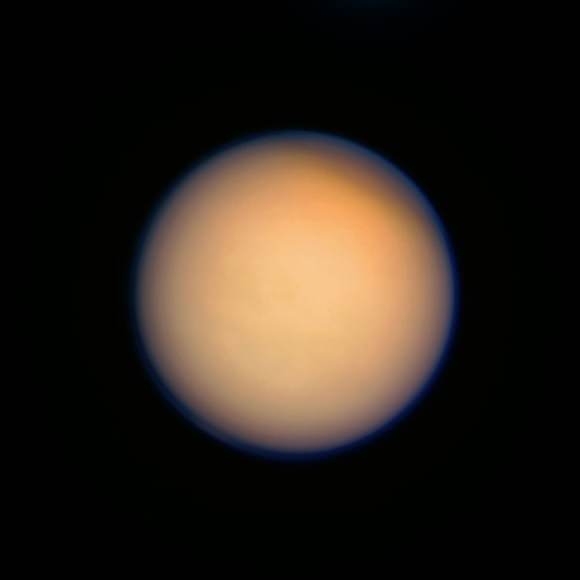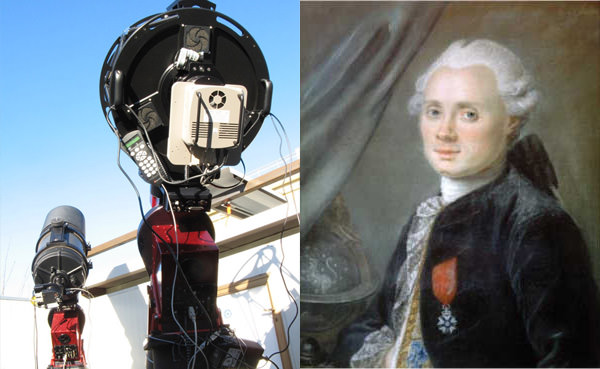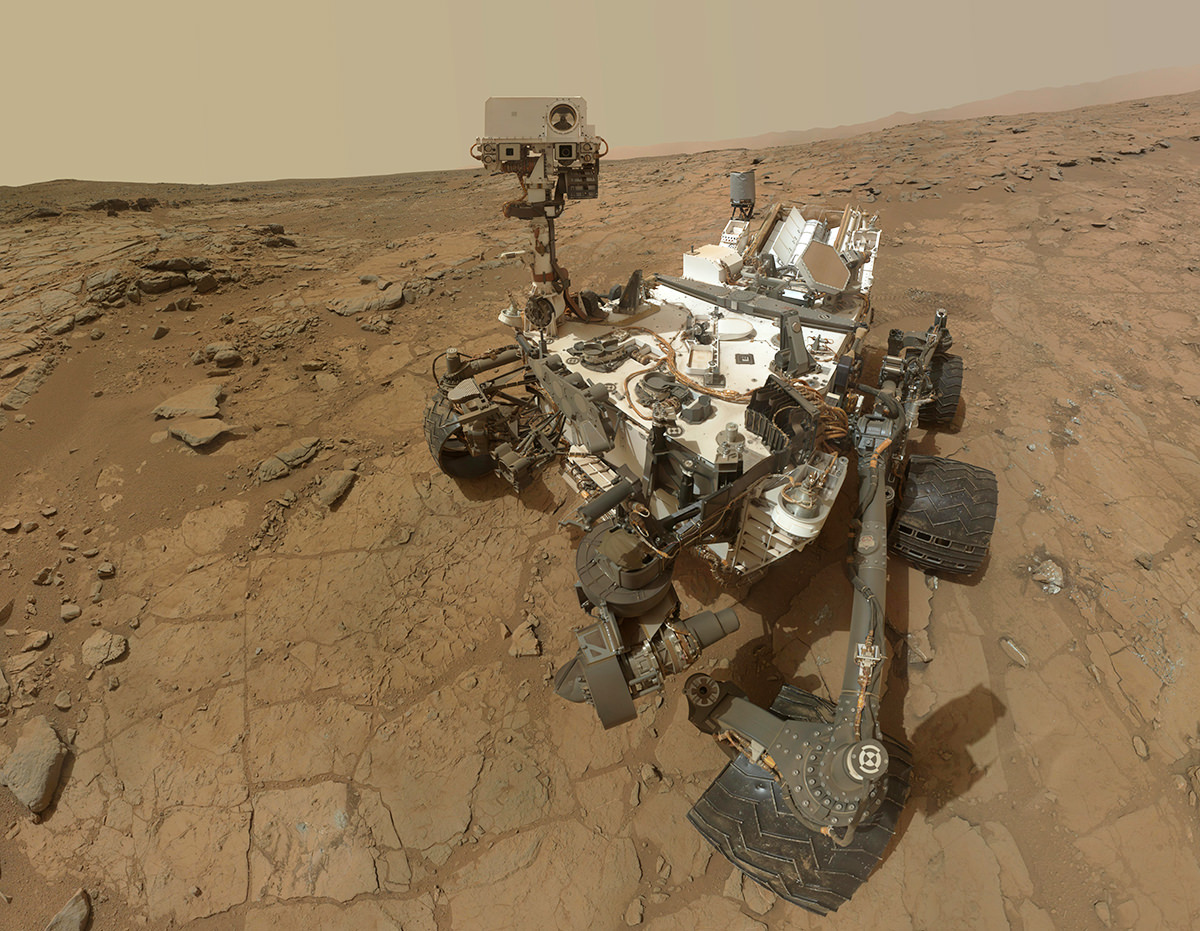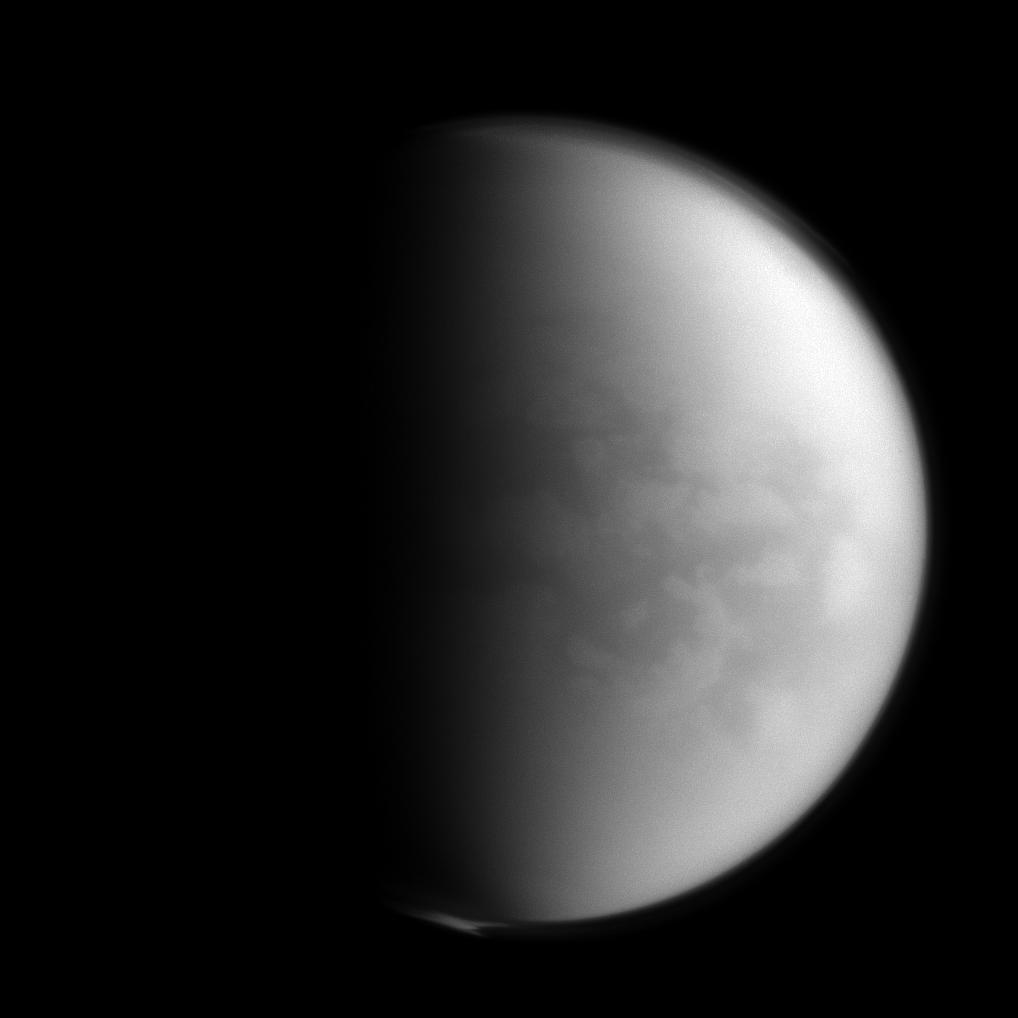No tears in heaven? Expedition 35 Commander Chris Hadfield shows that while you really can cry in space, tears don’t fall like they do here on Earth, and instead just end up as a big ball of water on your face. It’s physics, baby!
The Beginning of the Universe in 3 Minutes
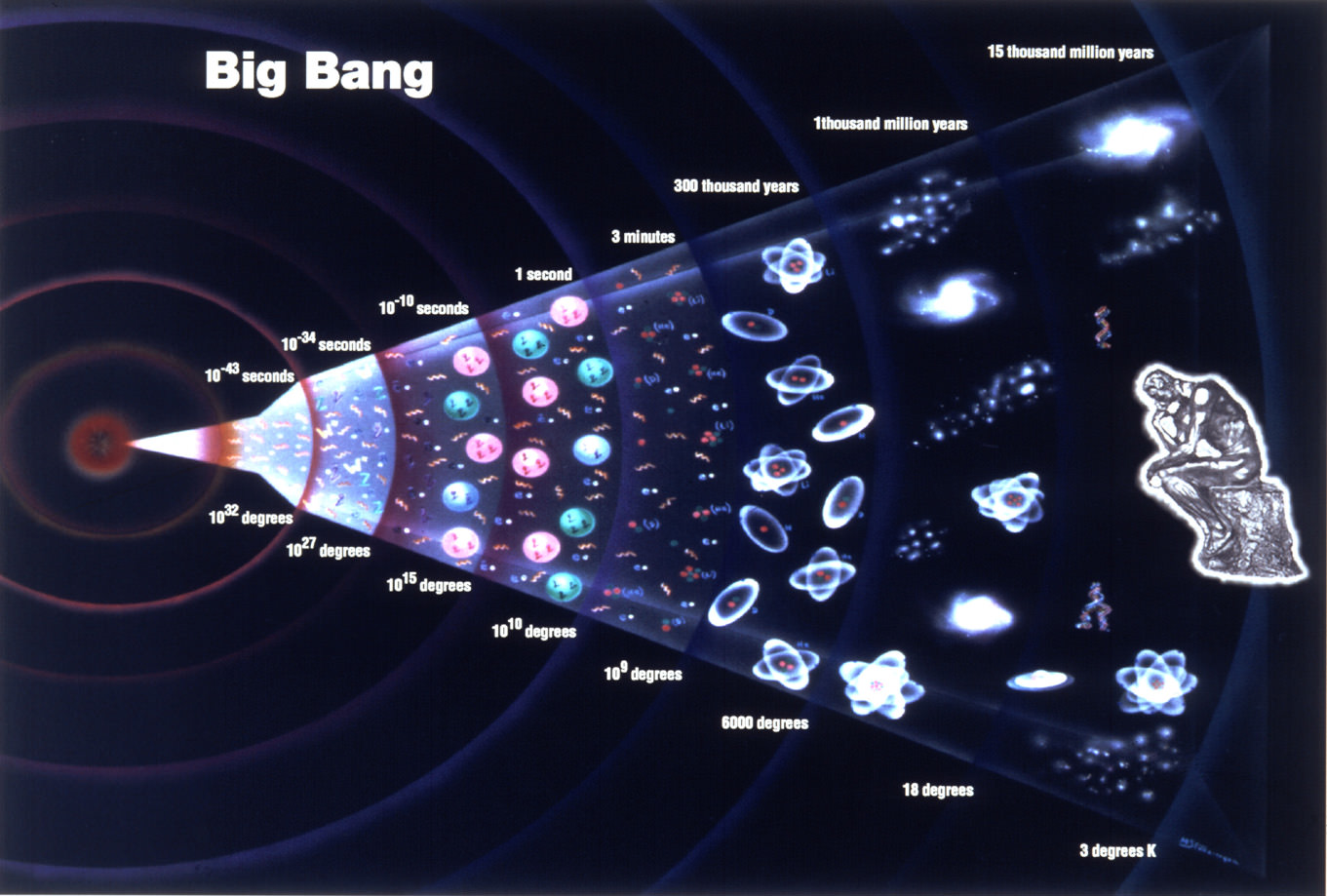
One of the greatest mysteries is how the Universe began — and also how and why does it appear to be ever-expanding? CERN physicist Tom Whyntie shows how cosmologists and particle physicists are exploring these questions by replicating the heat, energy, and activity of the first few seconds of our Universe, from right after the Big Bang.
Join in an Online Messier Marathon
Have you ever done a Messier Marathon? Want to try it online from the comfort of your own home? Astrophysicist Gianluca Masi will host a webcast today (April 9, 2013) at 18:00 UTC (2 pm EDT) (update: this webcast has been postponed due to clouds. We’ll post the new date and time when it becomes available). You can join in at this link, and explore the many treasures of the famous Messier Catalog. Masi said they will try to see as many of 110 objects in the Messier Catalog as possible in a single viewing session. This is what is called a Messier Marathon!
This is the fifth time the Virutal Telescope Project has attempted this, and they’ve had great success previously. Masi is doing the Marathon their robotic telescopes, and will provide real time images and live comments, along with answering your questions and “sharing your passion and excitement with friends from all around the world.”
For more information on how to join in see the Virtual Telescope Project’s website. For more info on a Messier Marathon and how to do one, see our excellent recent post by David Dickinson.
Here’s some examples of what you will be seeing today during the webcast:
How To Crowdsource Astronomy Without People Messing It Up
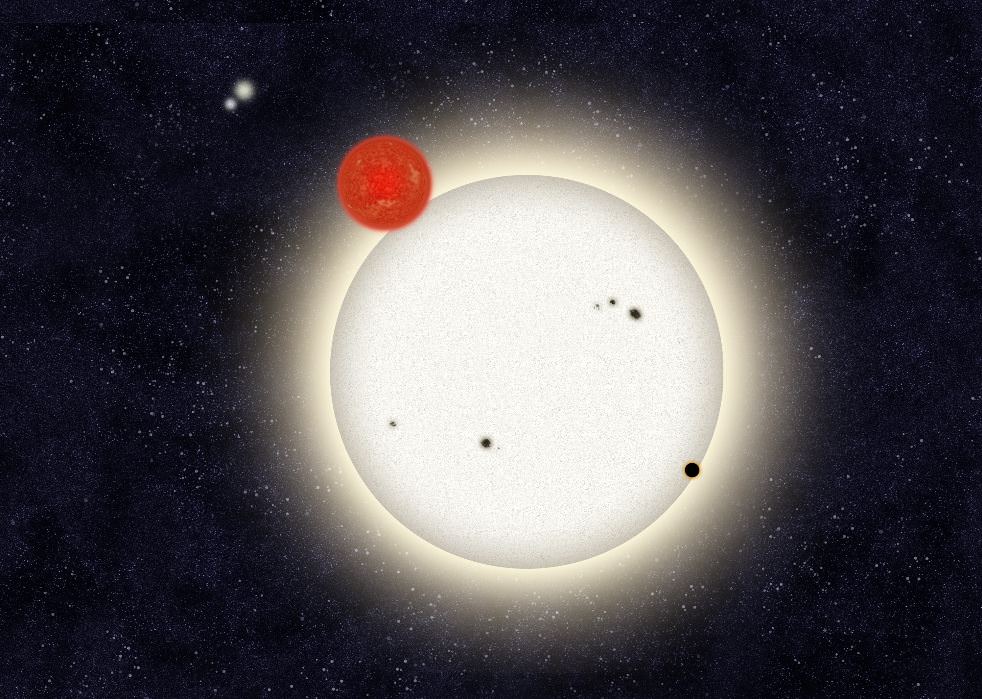
Maybe it’s because Jurassic Park is in theaters again, but we at Universe Today sometimes worry about how one person can mess up an otherwise technologically amazing system. It took just one nefarious employee to shut down the dinosaur park’s security fences in the movie and cause havoc. How do we ensure science can fight against that, especially when everyday citizens are getting more and more involved in the scientific process?
But perhaps, after talking to Chris Lintott, that view is too suspicious. Lintott is in charge of a collaborative astronomy and science project called the Zooniverse that uses public contributions to fuel some of the science he performs. Basically, anyone with an Internet connection and a desire to contribute can hunt for planets or examine astronomical objects, among many other projects.
Lintott, an astrophysicist at the University of Oxford, says the science requires public contributions. Moreover, he hasn’t had a problem yet despite 800,000 individual contributors to the Zooniverse. He told Universe Today about how that’s possible in an e-mail interview.
1) Zooniverse has already produced tangible scientific results in space through collaborating with ordinary folks. Can you talk about some of the papers/findings that have been produced in your various projects?
There’s a long, long list. I’m particularly excited at the minute about our work on bulgeless galaxies; most spiral galaxies have a bulge full of old stars at their centre, but we’ve found plenty that don’t. That’s exciting because we think that means that they’re guaranteed not to have had a big merger in the last 10 billion years or so, and that means we can use them to figure out just what effect mergers have on galaxies. You’ll be hearing more about them in the next year or so as we have plenty of observing time lined up.
I’m also a big fan of Planet Hunters 1b, our first confirmed planet discovery – it’s a planet in a four-star system, and thus provides a nice challenge to our understanding of how planets form. We’ve found lots of planet candidates (systems where we’re more than 90% sure there’s a planet there) but it’s nice to get one confirmed and especially nice for it to be such an interesting world.
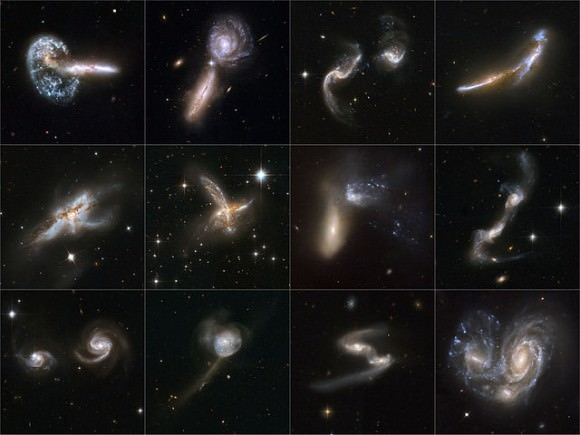
2) What benefits have you received from involving the public in space projects, in terms of results as well as raising awareness?
We couldn’t do our research any other way. Astronomers have got very good in the last few decades at collecting information about the universe, but we’re not always so good at learning how to use all of that information. The Zooniverse allows us to collaborate with hundreds of thousands of people so that we can scale our efforts to deal with that flood of data, and many of those volunteers go much further than just clicking on buttons we provide. So really our research is now driven in collaboration with thousands of people, spread all around the world – that’s an inspiring thought.
3) How many people do you manage in your space projects, approximately? How do you keep track of them all?
We have more than 800,000 registered volunteers – luckily, the computer keeps track of them (when they log in!).
4) How do you ensure their results meet the standards of scientific publication?
We carefully design projects so that we’re sure they will produce scientifically useful results before they’re launched; this usually means running a test with a small amount of data and comparing work done by volunteers with that of professionals. We usually find the volunteers are better than us! It helps that we have several people complete each task, so collectively we don’t make accidental mistakes.
5) How do you guard against somebody deliberately or accidentally altering the results?
The system insists that every classification is independent, and as we have several people look at each classification finding any deliberate attack would be easy – in any case, we’ve never seen any evidence of such a thing. Despite popular reports, most people are nice!
Celebrate Earth Month with 2 New Videos from NASA
Enjoy some great views of our home planet from images taken from the orbiting Earth-observing satellites and taken by astronauts on the International Space Station. The satellites and scientists are cranking out data 24/7 to help us all better understand and sustain our home planet.
Above is a video created for Earth Month, and specifically Earth Day (April 22) from ISS imagery, and below is another video from satellite imagery. These are unique looks at the beauty and wonder of our home planet.
Two New Online Astronomy Courses from CosmoQuest
Want to learn more about our Universe or refresh your astronomical knowledge? Cosmoquest has two new online astronomy classes, and they are a great opportunity expand your horizons! The two classes are “The Sun and Stellar Evolution” (April 15 – May 8, 2013) and “Introduction to Cosmology” (April 23 – May 16, 2013) Cosmoquest offers the convenience of an online class along with live (and lively!) interaction with your instructor and a small group astronomy enthusiasts like yourself. The lectures are held in Google+ Hangouts, with course assignments and homework assigned via Moodle.
The instructors are likely well-known to UT readers. Research assistant and blogger Ray Sanders (Dear Astronomer and UT) will be teaching the stellar evolution class and astronomer and writer Dr. Matthew Francis will be leading the cosmology course.
The cost for the class is $240, and the class is limited to 8 participants, with the possibility for an additional 5 participants. Both instructors say no prior knowledge of cosmology or astronomy is needed. There will be a little math, but it will be on the high school algebra level. Concepts will be heavily emphasized.
Here are the descriptions for each class:
The Sun is a fascinating topic of study, which allows solar astronomers to better understand the physical processes in other stars. During this 4-week / 8-session course, we’ll explore the Sun and Solar Evolution from an astronomer’s point of view. Our course
will begin with an overview of the Sun, and solar phenomenon. We’ll also explore how stars are formed, their lifecycles, and the
incredible events that occur when stars reach the end of their lives. The course will culminate with students doing a short presentation on a topic related to the Sun or Stellar Evolution.
Cosmology is the study of the structure, contents, and evolution of the Universe as a whole. But what do cosmologists really study? In this 8-session course, we’ll look at cosmology from an astronomy point of view: taking what seems like too big of a subject and showing how we can indeed study the Universe scientifically. The starting point is the smallest chunk of the Universe that is representative of everything we can see: the Cosmic Box.
Class level: No prior knowledge of cosmology or astronomy is needed. There will be a little math, but it will be on the high school algebra level: the manipulation of ratios and use of some important equations. The emphasis is on concepts!
More information and signup instructions can be found here at Cosmoquest.
A Detailed Look at the Coma of Comet PANSTARRS
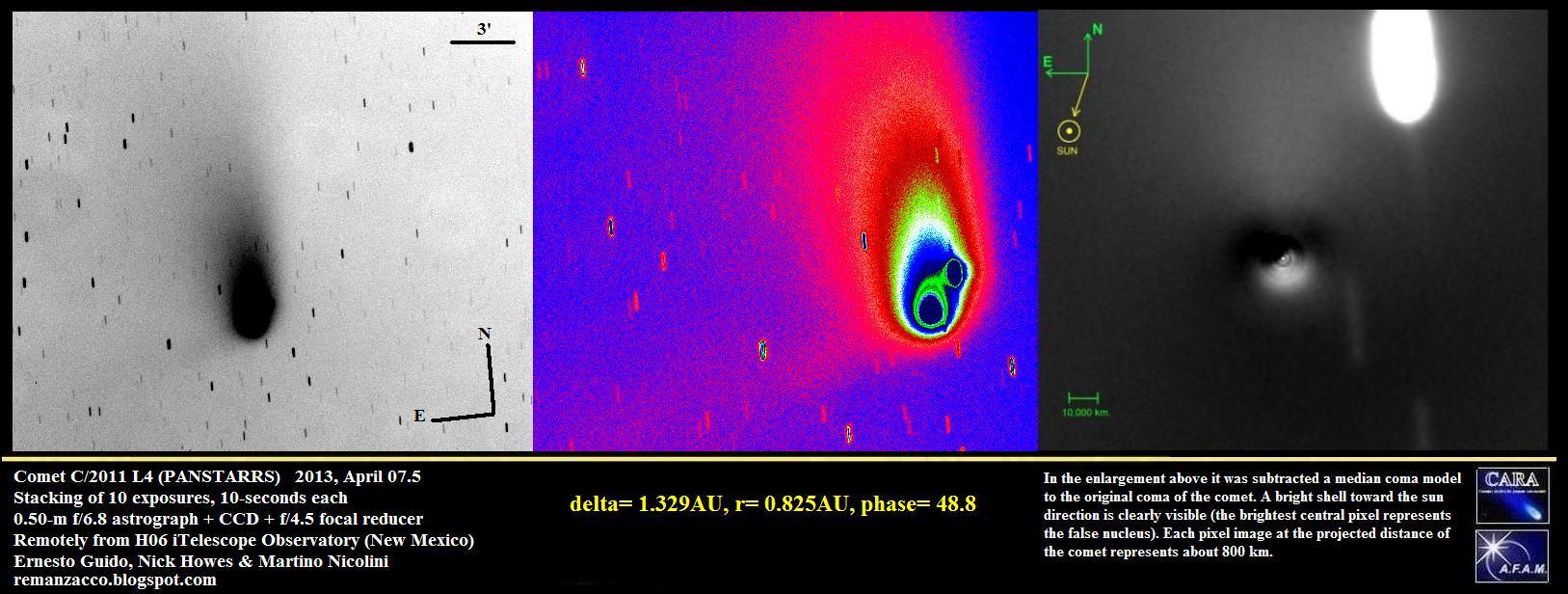
Comet PANSTARRS has peaked, but astronomers are still keeping an eye on this comet to try and determine what its future might hold. The team from the Remanzacco Observatory has just produced some really interesting views of Comet PANSTARRS, with a little help from Martino Nicolini and his Astroart software.
Team member Nick Howes called this software “one of the best astronomical image processing and acquisition tools around,” and explained how these views can tell astronomers more about what is happening with the comet.
“The isophotes image (color coded) is a good way to see the morphology/structure of the coma,” he told Universe Today, adding that comparing the images here is “a very good way to determine any major events like a fragmentation. We’re hopeful that once PANSTARRS gets a bit higher, we’ll be able to look at it in even more detail with the 2 meter Faulkes scopes.”
And with the image processing in the image on the far right, it’s possible to see a bright shell in the coma of comet C/2011 L4 (PANSTARRS).
“The last elaboration in that image has been obtained using the M.C.M. (Median Coma Model), a filter that has the purpose of creating — from an image of a comet — a synthetic model of the ‘regular’ coma,” said Ernesto Guido, from the Remanzacco team. “That is obtained by mapping all the pixels that compose the image and averaging them together. In doing so we delete all the morphological “non-uniformity” contained in the coma itself. This regular coma will then be subtracted from the original image highlighting all the details that are normally immersed in the uniform brightness of the coma.”
Check out the Remanzacco website for more information and their continued updates.
More Evidence That Mars Lost Its Atmosphere
Although today Mars’ atmosphere is sparse and thin — barely 1% the density of Earth’s at sea level — scientists don’t believe that was always the case. The Red Planet likely had a much denser atmosphere similar to ours, long, long ago. So… what happened to it?
NASA’s Curiosity rover has now found strong evidence that Mars lost much of its atmosphere to space — just as many scientists have suspected. The findings were announced today at the EGU 2013 General Assembly in Vienna.
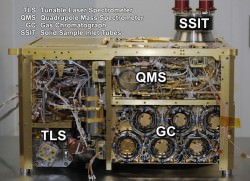
Curiosity’s microwave oven-sized Sample Analysis at Mars (SAM) instrument analyzed an atmosphere sample last week using a process that concentrates selected gases. The results provided the most precise measurements ever made of isotopes of argon in the Martian atmosphere.
Isotopes are variants of the same element with different atomic weights.
“We found arguably the clearest and most robust signature of atmospheric loss on Mars,” said Sushil Atreya, a SAM co-investigator at the University of Michigan.
SAM found that the Martian atmosphere has about four times as much of a lighter stable isotope (argon-36) compared to a heavier one (argon-38). This ratio is much lower than the Solar System’s original ratio, as estimated from measurements of the Sun and Jupiter.
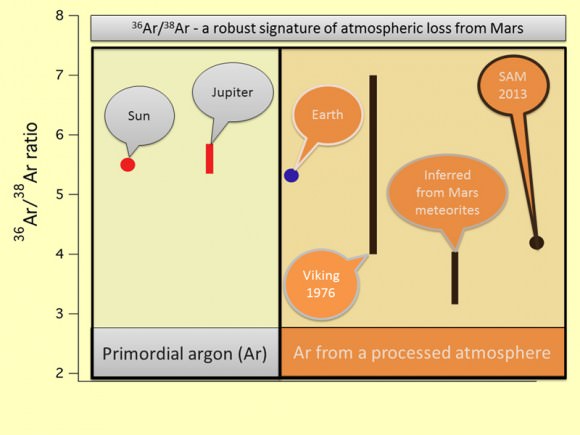
This also removes previous uncertainty about the ratio in the Martian atmosphere in measurements from NASA’s Viking project in 1976, as well as from small volumes of argon extracted from Martian meteorites retrieved here on Earth.
These findings point to a process that favored loss of the lighter isotope over the heavier one, likely through gas escaping from the top of the atmosphere. This appears to be in line with a previously-suggested process called sputtering, by which atoms are knocked out of the upper atmosphere by energetic particles in the solar wind.

Lacking a strong magnetic field, Mars’ atmosphere would have been extremely susceptible to atmospheric erosion by sputtering billions of years ago, when the solar wind was an estimated 300 times the density it is today.
These findings by Curiosity and SAM will undoubtedly support those made by NASA’s upcoming MAVEN mission, which will determine how much of the Martian atmosphere has been lost over time by measuring the current rate of escape to space. Scheduled to launch in November, MAVEN will be the first mission devoted to understanding Mars’ upper atmosphere.
Find out more about MAVEN and how Mars may have lost its atmosphere in the video below, and follow the most recent discoveries of the MSL mission here.
Source: NASA/JPL
Want to be an Astronaut? Learn How to Speak Russian
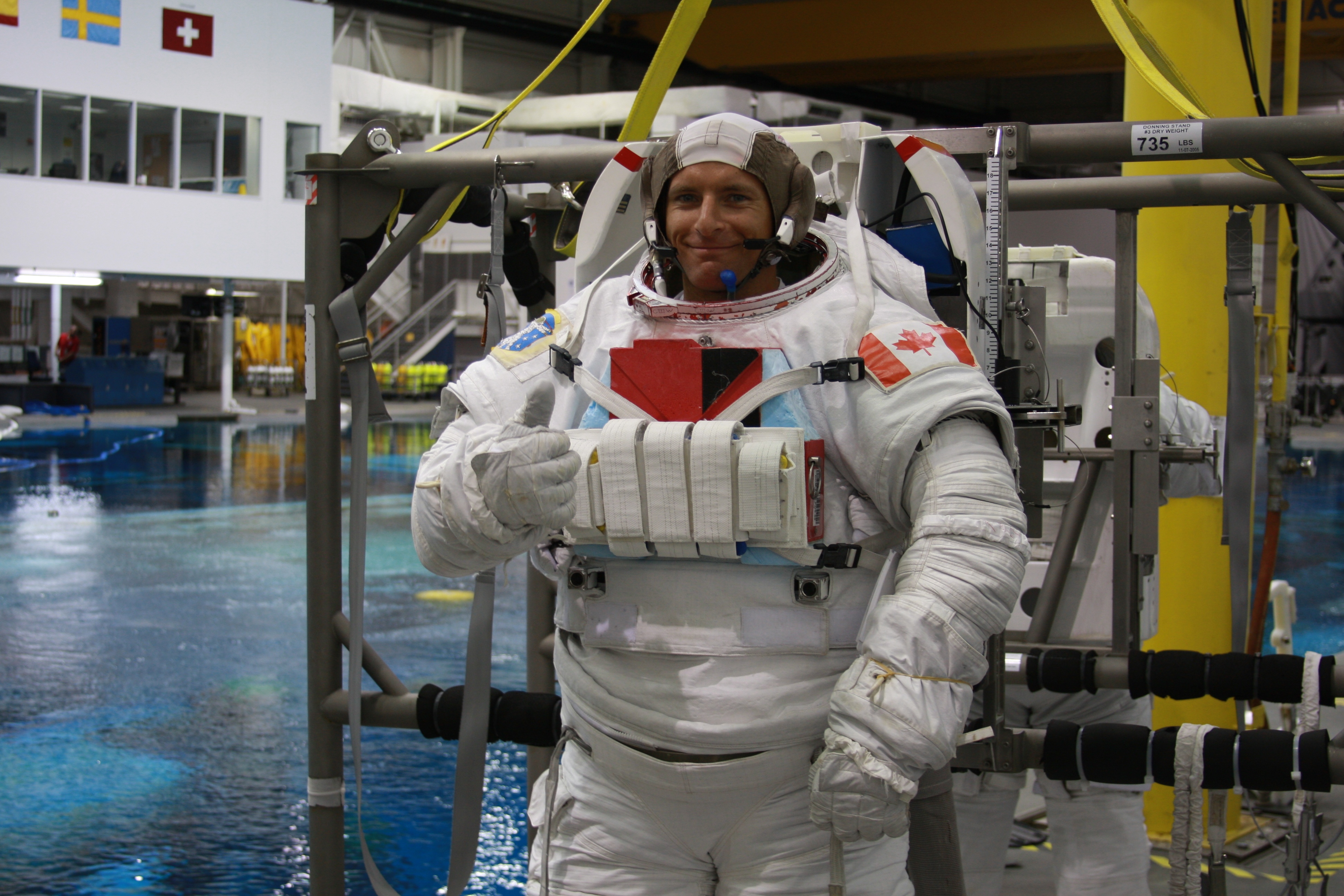
A fire breaks out on the International Space Station while the orbiting complex is over Russian mission control. How, as an English-speaking astronaut, would you keep up with instructions?
The answer is years of Russian training. In between time in simulators, jet airplanes and underwater, neophyte astronauts spend hours learning to read Cyrillic characters and pronounce consonant-heavy words. In fact, one of NASA’s requirements for its astronauts now is to learn the Russian language.
“It’s taken very seriously in the program because of the level you need to reach if, God forbid, there was an emergency on board and there was a panicky discussion going on in Russian on the radio,” Canadian astronaut and medical doctor David Saint-Jacques told Universe Today. “Ultimately, you need to be fluent to be really useful in a situation like that.”
Saint-Jacques himself is no neophyte to language learning. A native francophone, he learned English in public school and really improved it when he was 15 and moved with his family to England for a year. Today he speaks it fluently. He also has some abilities in Japanese, a language he picked up while in that country for a junior academic position at a university.
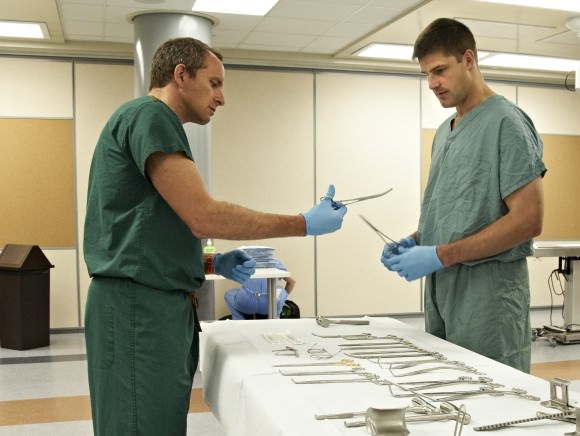
Now approaching four years as an astronaut trainee, Saint-Jacques told us how astronauts learn Russian. It’s a process that not only includes classroom instruction, but time living with a family in Moscow to really pick up on colloquialisms. Below is an edited interview.
What language training focuses on: “The point is not to write perfectly. The point is to communicate, similar to how businessmen learn languages. The emphasis for us is understanding spoken language, but the emphasis for us, the vocabulary, is different. I know all these obscure space hardware words and these crazy Russian space acronyms, but I may not know some of the flowers, for example. I can’t know everything.”
Basic Russian training: “We have Russian classes one-on-one with a Russian instructor. We get anything between one lesson every two weeks to three, four lessons a week, depending on how you accommodate the training schedule. Most astronauts want as much training as possible. It’s part of the requirements for basic training; you have to pass a certain competency test in Russian. There is a standard test that is used by the foreign affairs department, and so we do the same test. It’s a verbal test where you call the examiner on the phone and you have a discussion with them on the phone. If you pass a certain grade on that test, you are good to go.”
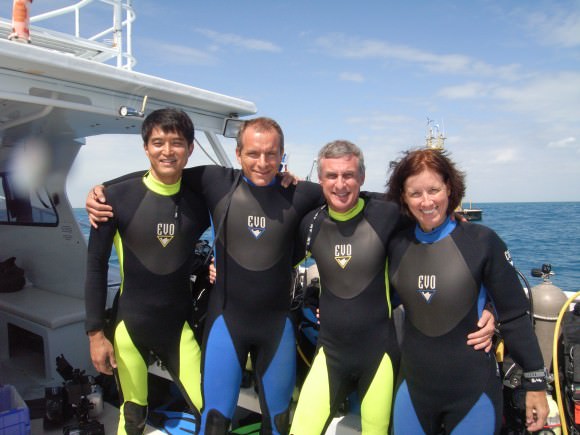
Living in Russia: “You have to go to Russia at some point to learn the Soyuz spacecraft and the Russian segment of space station. That, of course, is in all in Russian. The training is in Russian and the books are in Russian. There are translators that could be there with you, but you don’t want to rely on an interpreter for class. It really hits home; the more you know, the better. You will be living there for months, and it’s a no-brainer: you have to speak Russian when you are going to Russia.”
Immersion: “I took some holidays there [in Russia] with my family. That’s one of the great things when you speak the language of the country; you have fun there. I try to hang out with any Russian cosmonaut that comes here to Houston to keep up with them. There are two other ways we can train: you can block two to three weeks to do an intensive Russian test where all you want to do [beforehand] is study Russian. Also, when you are assigned to a spaceflight, in the year before your spaceflight, they [NASA] will try to send you for a month and a half in Moscow in a family for total immersion. That makes most people bump up their Russian level quite a lot.”
Side benefits: “It makes you realize how at the end of the day, international relations is really a form of personal relations, and speaking a language is absolutely fundamental. It makes you graduate from having a professional experience to a life experience with the other person, the other country.”
Cassini Says “Senkyo Very Much”
In this image acquired on January 5, Cassini’s near-infrared vision pierced Titan’s opaque clouds to get a glimpse of the dark dune fields across a region called Senkyo.
The vast sea of dunes is composed of solid hydrocarbon particles that have precipitated out of Titan’s atmosphere. Also visible over Titan’s southern pole are the rising clouds of the recently-formed polar vortex.
For a closer look at Titan’s dunes (and to find out what the name Senkyo means) keep reading…
In the image above north on Titan is up and rotated 18 degrees to the right. It was taken using a spectral filter sensitive to wavelengths of near-infrared light centered at 938 nanometers.
The view was obtained at a distance of approximately 750,000 miles (1.2 million kilometers) from Titan.
Titan’s hydrocarbon dunes are found across the moon in a wide swath within 30 degrees of the equator and are each about a kilometer wide and tens to hundreds of kilometers long… and in some cases stand over 100 meters tall. (Source: Astronomy Now.)
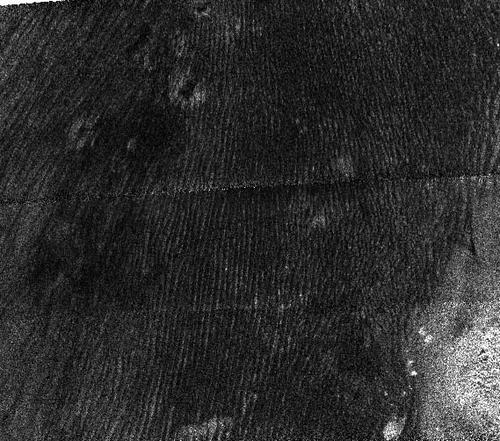
Observations of the dunes with Cassini and ESA’s Huygens probe during its descent onto Titan’s surface have shown that the moon experiences seasonally-shifting equatorial winds during equinoxes, similar to what occurs over the Indian Ocean between monsoon seasons.
The name Senkyo refers to the Japanese realm of serenity and freedom from wordly cares and death… in line with the IAU convention of naming albedo features on Titan after mythological enchanted places.
Click here for an earlier view of Senkyo, and follow the Cassini mission here.
